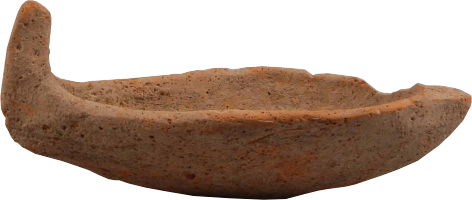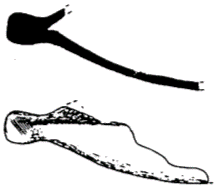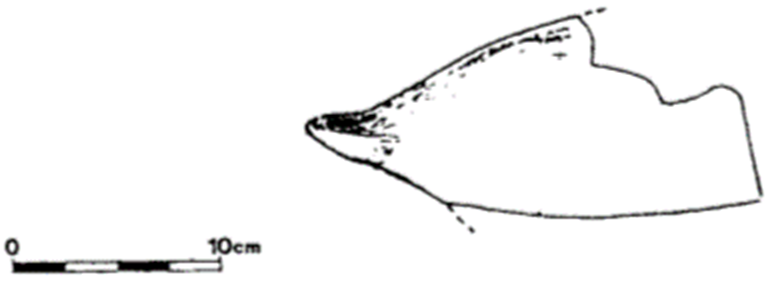Ship model fragment
L34
10th-end 9th century B.C.
Achziv, South cemetery, tomb T.C. 4
L: 20 cm
Terracotta model, yellowish brown clay
Reg. no. 3129
Mazar 2003: 19, 44, 45, fig. 18.2
The vast majority of the tombs in the southern cemetery were used continuously for many generations over hundreds of years, until the end of the Iron Age. Exceptions to this rule are tomb T.C. 3 (end 11th-beginning of the 10th) and tomb T.C. 4 (10th- end of 9th). These represent the earliest built tombs at the site and have a unique building style (rough stones) that does not continue among later tombs.
Tomb T.C. 4 received a large number of secondary burials which appear to have been moved from another location to the southern cemetery. The excavators hypothesize that this may be due to the "clearing" of the northern cemetery sometimes in the 10th to 9th century when it was converted into a cremation only burial ground. The family tomb contained remains of approximately 50 individuals (men, women and children), with all burials save one being secondary. Chamber tomb T.C. 4 is located 6 m to the northwest of T.C. 2 and 7 m southwest of T.C. 1. It was never finished and is built in the rough-stone style, its foundation penetrating into a LBA stratum, occasionally reaching even deeper into meagre MBA remains. The original burial consists of a foundation trench that received the skeleton. The remaining bones represent secondary burials that accumulated over time, filling the tomb up to 1 m. These remains were deposited in the tomb in no apparent order save for a few groups of 2-3 skulls.
A jug was found on the floor level of the dromos, while large quantities of pottery were discovered mixed with the bones. The most common types include bowls with simple rims, bichrome jugs and trefoil rim jugs, as well as pilgrim flasks of varying size. Also recovered were two jars, dipper juglets, BOR juglets, Cypriot WP juglets, an oil lamp and the fragmentary boat model. The tomb boasted numerous small finds such as weights, seals, and beads. The occupants also enjoyed access to prestigious grave goods, most notably ivory staffs, one of which had a pomegranate head. The boat is too fragmentary for technical observations.
Mazar, E. 2003. The Phoenicians in Achziv: The Southern Cemetery. Jerome L. Joss Expedition: Final Report of the Excavations 1988-1990. Cuadernos de Arqueologia Mediterranea 7. Barcelona: Carrera Edició, Publicaciones del Laboratorio de Arqueología, Universidad Pompeu Fabra de Barcelona.







